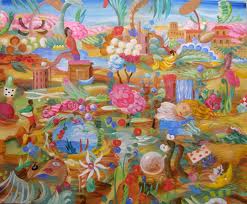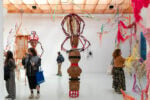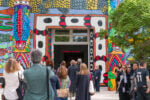David Bowes – Ritorno a Napoli

Mostra personale
Comunicato stampa
A Conversation with David Bowes
Alan Jones
What were your first impressions of Naples when you arrived here in the Eighties?
The omnipresence of a living popular culture made a deep impression on me. I had a sense of real daily life, coming from outside and being brought right into the heart of the city and its rhythm. It was fabulously mysterious to me, and yet the mysteries I was absorbing were very intimate ones. I was lucky to discover Naples through Lucio Amelio. He was so much a part of the city, and the city was part of him. In the course of a day we would pass by the office of a newspaper, run into the director of the opera on the street, and in this way, all very casually, I got to know the city.
How was it that you came to live in Naples?
Lucio Amelio telephoned and said he wanted to include my work in Terrae Motus, the gigantic group show he was organizing. The show opened in March 1986. He sent me a ticket, and I arrived from Munich. It was already spring in Naples and I was very happy to be in this new place bursting with sunlight. I had met Lucio Amelio before, in New York, when I was showing at the gallery of Annina Nosei, but I'd never spent much time with him. He was very dynamic, very charismatic, that I knew. His spontaneity, enthusiasm, his energy, were contagious. After a week in Naples I decided I'd like to stay there. I asked him what he thought. "We'll find you a studio, and do a show in the spring." Just like that. He had a talent for getting things done, the very model of the impresario. An amazing feeling for art, incredible taste in clothes, an artist in his own right. Beyond being an art dealer, he was like a collaborator.
It sounds like a conspiracy among pirates. Andy Warhol, Joseph Beuys... What was his approach to working with artists?
He had this gift for getting inside what the artists were doing, to anticipate intuitively all the things they required to accomplish their work, and to do this as if by magic. He made it look so easy. In the case of Beuys, for example, this meant a particular set of things very different from what made Warhol comfortable. He just knew. What was so special for me was the feeling that he was on my side. For Lucio, the artist always came first.
Naples possesses one of the most extraordinary places in the world, the National Archeological Museum. An hallucinatory experience.
Spending afternoons there was like a religious pilgrimage. I was always enamored of ancient Roman painting, which is how we can get an idea of ancient Greek painting: the beautiful naturalism, the decorative detail, a kind of existentialist perspective so much more convincing than the scientific perspective of the Renaissance, this keenly observed natural experience, wildlife and the human form rendered in a swift sure hand. This is always with me. The human form and architecture in a jumble of contradictory perspectives, exactly the way we see as we walk through a group of buildings: we are not immobile, fixed in a single point of view.
Each of your paintings seems a chapter of an on-going story, a group of actors appearing and reappearing on the stage, so the viewer is drawn onto the itinerary.
You want to keep their eye on the painting. One way is to keep them moving between a few elements, so the theme is not merely a focal point but is being crossed and crossed by a glance that is gathering other elements.
In the painting of ancient Rome, its way of organizing figures, buildings, mountains in a landscape, one sometimes feels something akin to classical Chinese painting.
One sees that also in your work, the rapport between near and far, the strange transitions.
It's no coincidence. They have a lot in common, because they both function the same way. They are fruit of the same ambition: to make a painting that is livable. It's there always; painted walls are ever present. So there are tangible things, then elements of space, and this harmony of an arrangement of objects that sit there in tranquility, a figure and then a tiny indication of architecture with a very distant group of figures in another space, maybe even in another time, and yet the rapport between these things is sublime. Chinese painting, and the painting we have from Pompeii, this is an old, old tradition which has been handled and refined until these things sing but never so loudly that they disturb what's going on in the room. They are there to be entered in a moment of reflection. They are only as quiet and as beguiling as necessary and they work well in every situation.
Again, the question of perspective.
It seems obvious that the Romans with their sense of engineering, mathematics and architecture could easily have arrived at mathematical perspective, but there is a complete denial of it until the Renaissance. We are talking about the Greek tradition, and Pompeii is what we have to imagine Greek painting which was famous in its day, of which there remains so little evidence outside of these frescoes. And certainly the Greeks in their architecture were handling very sophisticated concepts together with a keen sense of human perception: how we actually perceive things, the calculated distortions in architecture. So mathematical perspective was well within their grasp. But their preoccupation was not in this case scientific, although they had the scientific means. In this case, it had maybe more to do with human experience, with poetry and existential reality.
In his "ut pictura poesis" Horace would seem to be hinting at some enigmatic trick of the trade, in terms of practical technique, in common between painting and poetry. Novelists such as Flaubert or Simenon begin with a detailed plan, while others such as Julien Green or Elmore Leonard set in motion the character or situation, without a preconceived drama. Flaubert follows his recipe in the kitchen while Green concentrates on the seating arrangement at the table... In the commedia dell'arte, the personae come to life by interacting with each other. How do you choreograph the encounters between figures?
There is an intuition of what works. Things work in many ways. I paint because it is a way of communicating that has nothing to do with language. The frame of these particular genres is a sort of set syntax, a way of speaking free from the need to use words. There are times when I have a clear feeling, and it's a joy, even in some very elaborate paintings. I have a sense from the beginning that I know what this is, and it's so clear that it paints itself. I can see it, and getting there I discover some things, I may struggle with certain elements, but I know where I'm going. And when it's finished, it becomes perfectly clear: it says this. Then I'm done. There are other times when it is much more confused, things are difficult to resolve... it's an engaging way to work, it can be more of a struggle, but in the end it can be as satisfying to finally seize from this threatening chaos something I could not have anticipated. The idea of a company of actors, that was a theme I used a lot at a certain point, because it was a pleasure to paint a lot of figures together, a challenge to have them all be real and individual and yet make sense as a whole. It was an interesting exercise. I like the theme of actors, but of course painting doesn't really have that aspect: there is an audience for painting, but the artist is rarely there when they are looking at your work.
The transaction occurs in another dimension; the destiny of a poem by Catullus is far different from that of a painting at Pompeii. What Maurice Rheims called "La vie étrange des objets..."
The Commedia dell'arte is always fun to interpret. The characters come so loaded with reverberations, it's such an eloquent way of communicating because they contain several worlds within them. I don't think that figurative painting is best served by narrative. I think that is a terrible confusion. If I occasionally make narrative paintings, the narrative is always simple. That's one thing. Marionettes are another: they wind up acting the same in the theater as in the context of the picture, but I painted them because they fascinate me in the same way as the paintings from Pompeii: just the beautiful sure quickness of the way they are painted, their immaculate immediacy, the authority of the arts and the means of communicating the features of a character, and the art of an expression that is so poignant, so human and yet neutral. Marionettes function in every dramatic situation. Those paintings were intended as an homage to great artifice.
Giorgio de Chirico could easily include in the same painting gladiators practicing and a couple of guys in suit and necktie watching them. You seem to have no problem placing Pulcinella against a background of modern skyscrapers.
That's just my experience. To me it's naturalism: a very antique fountain surrounded by contemporary school kids and tourists. Maybe it also has something to do with being American. The urban scene in America is full of neo-classical buildings, inspired by antiquity, right next to fast food restaurants, neo-gothic churches next to shopping malls. That's just our ordinary experience. There is no need for Surrealism and startling juxtapositions of shocking elements: our daily life is already pretty shocking visually.
Landscape versus still life. The panoramic John Ford longshot or the Hitchcock close-up...
Landscape and still life are not all that different. It's a question of scale and intimacy. Still life is a kind of field with elements placed in it much as in a landscape, a very static landscape painted in a more intimate manner. You can see that in Morandi: his placement of objects on a plane just below his line of sight, so you are looking directly into them. That's a fascinating way to encounter objects: painting things the way we perceive them in a room, sitting on planes below our line of sight. I think of the still lives of Pirandello, simple objects left during the course of a day and then encountered as you re-enter a room after work. It's life as we perceive it, caught out of the corner of the eye. And then something else, which is poetry: an empty chair in its insinuation of a person is always a poignant theme. Chairs are wonderful to paint because they have so much personality. You are defining something by its absence. That's the difference, that kind of theater of the still life, while maybe landscape speaks of something more diffuse. I identify with painters I know from the past, I think about their daily lives, the kind of quiet it takes to slow down to the right speed in order to paint. It takes stepping out of the contemporary rush of things. Even in Manhattan, it's possible to close the door. Outside, there is all the energy of the city, but what you are doing is really a very slow, quiet activity. Painting is not a very contemporary activity. I think of Chardin a lot.
A long way from the vast landscapes of Poussin, or Brueghel, punctuated by tiny figures.
The smallness of our existence in confrontation with the enormity of nature and space, this inevitably suggests time: our fleeting tiny existence in an engaging, deeply mysterious enormity. Brueghel's Fall of Icarus is a beautiful painting. His way of including everything: here is life on earth, everything going on at the same time, ships coming and going, fields being plowed, a town in the distance maybe, people going on about their lives. It makes a mythic tale immediate. Remember it happened! Here is the world in which it happened. It says to the viewer, "this happened while you were nearby." To make it real. There is wit, too, because of the tinniness of the figure: the figure's tragedy is only happening to him. There is something profound and very human about not making that the central theme.
Unesco travels the world declaring cities to be "patrimony of humanity" much as Duchamp baptized readymades. But there is also an official list of quite a different nature: the Metaphysical Cities of Giorgio de Chirco: Ferrara, Florence, Paris, Venice, New York, Rome... Returning to live in Italy, several years ago you chose to settle in another officially metaphysical city, neutral and anonymous yet strangely engaging: Turin.
I was intrigued when I first came here. I thought of De Chirico from the outset, because of the architecture and certain elements we know from his painting. It's a mysterious city. It is also kind of a blank, which is something I like. Turin suggests nothing in particular. There is a sense of arte povera that lingers in the air, but it is a city that doesn't insist on one thing or another. So to me, it was an easy foreign place to be working in. It left me the space to do exactly what I wanted. I also thought I could make paintings here that I wouldn't have made anywhere else, and this turned out to be true. I have done paintings here that I never would have done in Boston. Turin serves me as a place to paint. A fresh field.
August 2013



